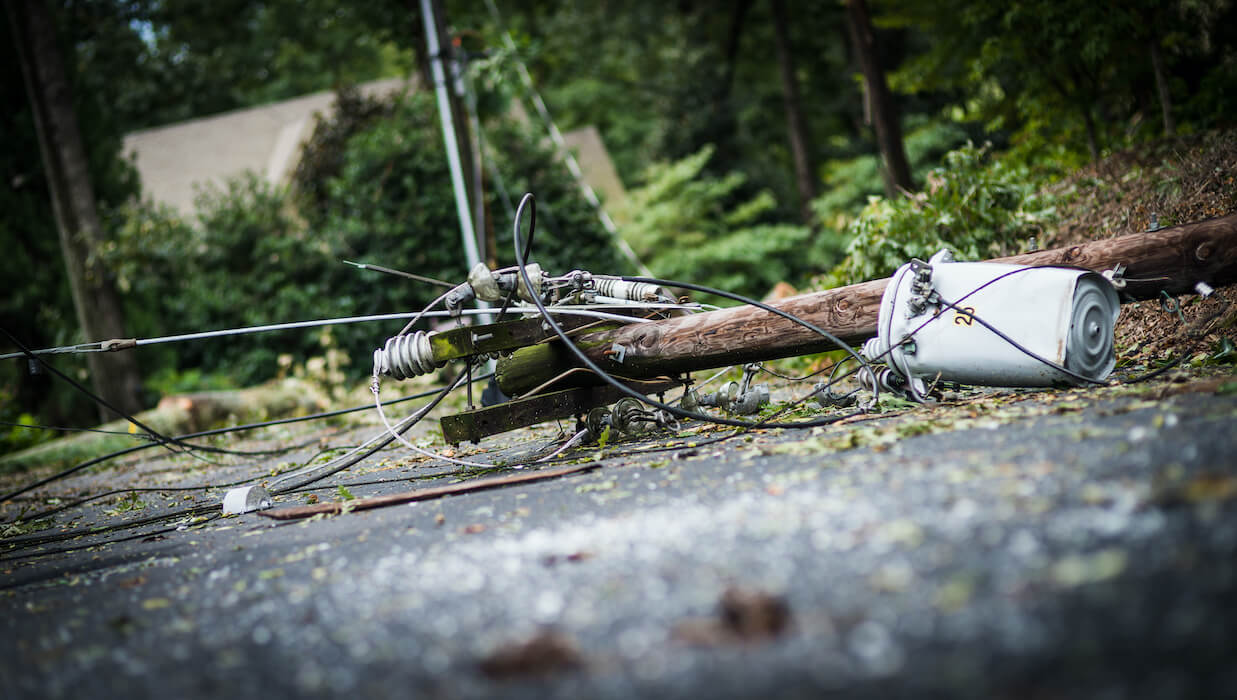Power outages are, thankfully, rare occurrences in many areas of Canada. While the sources of electricity generation vary between natural-gas fired turbines, hydroelectric dams, wind, and nuclear, the transmission and distribution systems that bring the electricity to our homes and businesses are typically very reliable. When the lights do go out, there can be a few different sources of the power outage and this article will discuss some of the more common types of failures that can cause issues.
Severe weather
Many people are familiar with power disruptions related to severe weather, such as the ice storms that occur in eastern Canada.
In December 2013, freezing rain in the GTA caused ice to build up on trees and branches, which eventually crashed down onto power lines. The branches tore down power lines or caused “ground faults” where electricity flowed from the line into the earth, which in turn activated protection elements such as fuses. The subsequent power outage left over 228,000 Toronto Hydro customers without power.
Other weather related sources of overhead line disruptions include high wind events, tornados, or even heavy snowfalls. If severe weather is inbound, it is wise to be prepared for a utility outage. Simple preparations such as having candles, flashlights and batteries, and firewood for fireplaces and wood stoves can help to prevent an inconvenience from turning into a life and death situation.

Less obvious cause
While some reasons for a power outage are obvious, such as a tree branch falling on an overhead powerline, sometimes the cause is less obvious. One such example is a failure of an underground service cable. These cables bring power from overhead transmission lines, pad-mounted transformers, or underground vaults to customer facilities.
For residential homes these cables will often be buried directly in the ground. For larger structures including commercial and industrial locations, these cables can have an armoured outer jacket or are encased in a protective conduit.
A failure of an underground cable can not only be more difficult to locate, but it can also be costly and time-consuming to repair. In the case of larger services for customers such as industrial and commercial locations, the energy released during a cable failure can cause catastrophic damage to not only the cable, but also to equipment at the utility transformer or in the main electrical room where it connects to other components.
Repairing the cable may involve excavation to locate and remove the damaged cable, and then installation of a new cable. The root cause of these failures can often be traced back to mechanical damage suffered during installation, ground movement, or aging and breakdown of the cable’s insulating covering. If you suspect an issue is developing with an underground electrical cable, contact a certified electrician who can conduct diagnostic testing, including insulation resistance measurements, which can help determine the overall health of the cable.
Issues with the indoor electrical system
Sometimes the cause of a power outage may be a lot closer to home than a faulted cable or tree branch on a power line. In condo buildings, apartments, or commercial buildings, incoming power is often fed at 600-volts rather than the 240-volts common in single family homes. The first stop for this incoming power will be a main panelboard or “switchgear”.
This piece of equipment is analogous to the main electrical panel in a typical home, however, it is a fair bit larger with some additional components. The switchgear will house the metering transformers, main buses, and circuit breakers for all of the different loads throughout the facility.
Because the incoming power is at a higher voltage with a larger current capacity, a failure within the main switchgear can be catastrophic. A poor connection can cause a hot spot that will lead to an eventual arc-fault and possible explosion.
Contamination from substances such as water or smoke can lead to a short circuit and subsequent power outage. Facility owners who have main switchgears as part of their building plant are advised to have regular inspections completed by technical specialists. These inspections can include insulation resistance measurements, visual examination, and infrared thermographic monitoring that can detect issues before they develop into catastrophic failures.
What about transformers?
One piece of equipment that we have not yet covered is transformers. These devices are present all along the power grid from the generation station all the way to the distribution transformers hanging on utility poles.
Depending on where the transformer is located, a fault can cause a widespread outage, a localized outage, or no outage at all due to utility redundancy.
Keep an eye out for an upcoming article where we will discuss the different types of transformers and some of the more common problems that can occur.
Whether the cause of a power outage is close to home or far upstream on the power grid, be sure to stay away from energized equipment and contact your local utility to report a disruption or downed line. If you have a specific question about an electrical failure and subsequent outage, contact the experts at CEP Forensic for more information.
